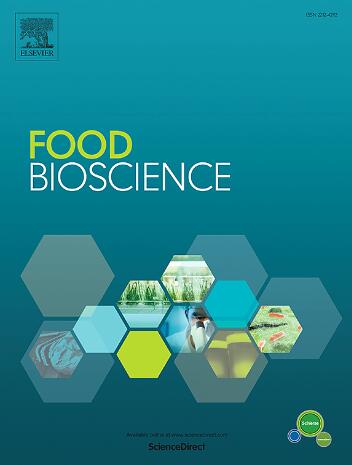Salt reduction-driven biogenic amine accumulation in broad bean paste: Insights into physicochemical properties, key enzyme activity, and microbial community dynamics
IF 4.8
1区 农林科学
Q1 FOOD SCIENCE & TECHNOLOGY
引用次数: 0
Abstract
The mechanisms governing biogenic amine (BA) production and the excessive accumulation of BAs in response to reduced salt content during broad bean paste (BBP) fermentation remain inadequately elucidated. This study conducted a comparative analysis of BBP fermentation under low- (LS, 6 %), medium- (MS, 9 %), and high-salt (HS, 12 %) conditions, emphasizing the dynamic changes in physicochemical properties, key enzyme activity, and microbial community dynamics, as well as their correlations with BA formation. The findings revealed that salt reduction accelerated the fermentation process, with LS samples exhibiting the most pronounced variations in pH, total acidity, and amino acid nitrogen. By the end of fermentation, these values reached 4.17, 0.64 g/100g, and 0.84 g/100g, respectively, whereas HS samples exhibited minimal changes, with final values of 4.90, 0.29 g/100g, and 0.67 g/100g. Additionally, LS samples displayed heightened protein hydrolysis activity, as evidenced by the highest acid protease activity (1.84 U/g vs. 1.47 U/g in HS) and protein degradation rates (44.45 % vs. 24.70 % in HS), resulting in a 1.55-fold greater accumulation of free amino acids at the end of fermentation (2.59 g/100g vs. 1.67 g/100g in HS). Moreover, the elevated amino acid decarboxylase activity in LS samples promoted substantial BA accumulation, with total BA content reaching 1346.81 mg/kg, compared to 854.69 mg/kg in MS and 764.22 mg/kg in HS samples. Mammaliicoccus, Tetragenococcus, and Staphylococcus were the dominant genera in the HS and MS samples, whereas Mammaliicoccus, Weissella, and Bacillus were predominant in the LS samples. Correlation analysis identified significant associations between pH reduction, protein hydrolysis, and BA formation patterns under different salt concentrations (P < 0.05). Differential analysis further indicated that the intensified pH decline and accelerated protein hydrolysis induced by salt reduction were primary contributors to the excessive accumulation of phenylethylamine, histamine, spermidine, and spermine, while the upregulation of amino acid decarboxylase activity specifically accounted for the elevated tyramine levels in reduced-salt samples. Microbial analysis indicated that Weissella, Bacillus, Companilactobacillus, and Pichia were key microbial factors involved in or promoting BA formation under reduced-salt conditions. These findings provide novel insights into the mechanisms underlying BA formation under varying salt concentrations and offer a scientific basis for improving the safety and quality of reduced-salt BBP.

豆瓣酱中盐还原驱动的生物胺积累:理化性质、关键酶活性和微生物群落动态的见解
豆瓣酱(BBP)发酵过程中盐含量降低导致生物胺(BA)产生和BA过度积累的机制尚不清楚。本研究对BBP在低盐(LS, 6%)、中盐(MS, 9%)和高盐(HS, 12%)条件下的发酵过程进行了对比分析,重点分析了BBP理化性质、关键酶活性、微生物群落动态变化及其与BA形成的相关性。研究结果表明,盐的减少加速了发酵过程,LS样品在pH值、总酸度和氨基酸氮方面表现出最显著的变化。发酵结束时,这些值分别达到4.17、0.64 g/100g和0.84 g/100g,而HS样品的变化最小,最终值为4.90、0.29 g/100g和0.67 g/100g。此外,LS样品显示出更高的蛋白质水解活性,酸性蛋白酶活性最高(1.84 U/g, HS为1.47 U/g),蛋白质降解率最高(44.45%,HS为24.70%),导致发酵结束时游离氨基酸积累量增加1.55倍(2.59 g/100g, HS为1.67 g/100g)。此外,LS样品氨基酸脱羧酶活性的提高促进了BA的大量积累,总BA含量达到1346.81 mg/kg, MS样品为854.69 mg/kg, HS样品为764.22 mg/kg。HS和MS样品的优势属为哺乳球菌、四小球菌和葡萄球菌,LS样品的优势属为哺乳球菌、魏氏球菌和芽孢杆菌。相关分析发现,不同盐浓度下pH降低、蛋白质水解和BA形成模式之间存在显著关联(P <;0.05)。差异分析进一步表明,盐还原引起的pH值下降加剧和蛋白质水解加速是苯乙胺、组胺、亚精胺和精胺过度积累的主要原因,而氨基酸脱羧酶活性的上调是盐还原样品中酪胺水平升高的具体原因。微生物学分析表明,Weissella、Bacillus、Companilactobacillus和Pichia是参与或促进低盐条件下BA形成的关键微生物因子。这些发现对不同盐浓度下BA的形成机制提供了新的见解,并为提高还原盐BBP的安全性和质量提供了科学依据。
本文章由计算机程序翻译,如有差异,请以英文原文为准。
求助全文
约1分钟内获得全文
求助全文
来源期刊

Food Bioscience
Biochemistry, Genetics and Molecular Biology-Biochemistry
CiteScore
6.40
自引率
5.80%
发文量
671
审稿时长
27 days
期刊介绍:
Food Bioscience is a peer-reviewed journal that aims to provide a forum for recent developments in the field of bio-related food research. The journal focuses on both fundamental and applied research worldwide, with special attention to ethnic and cultural aspects of food bioresearch.
 求助内容:
求助内容: 应助结果提醒方式:
应助结果提醒方式:


